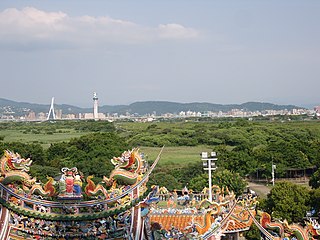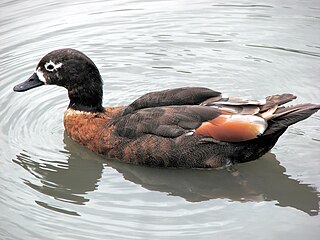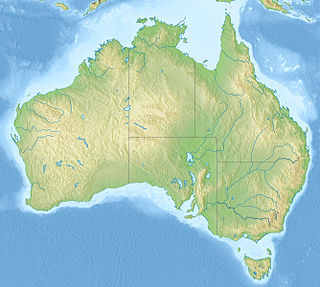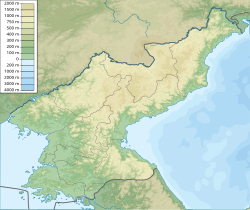
The Oreti River is one of the main rivers of Southland, New Zealand, and is 170 kilometres (110 mi) long. The river has been identified as an Important Bird Area by BirdLife International because, for much of its length, it supports breeding colonies of black-billed gulls.

An Important Bird and Biodiversity Area (IBA) is an area identified using an internationally agreed set of criteria as being globally important for the conservation of bird populations.
The Ch'ŏngch'ŏn is a river of North Korea having its source in the Rangrim Mountains of Chagang Province and emptying into the Yellow Sea at Sinanju. The river flows past Myohyang-san and through the city of Anju, South P'yŏngan Province. Its total length is 217 km (135 mi), and it drains a basin of 9,553 km2.

Bates Island is a narrow island 5 km (3.1 mi) long lying east of Jurva Point, Renaud Island, in the Biscoe Islands of Antarctica. It was first accurately shown on an Argentine government chart of 1957, and was named by the UK Antarctic Place-Names Committee in 1959 for Charles C. Bates, an American oceanographer who has specialised in sea ice studies.
Watson Peninsula is a narrow peninsula 4 km (2.5 mi) long separating Macdougal and Marr Bays on the north coast of Laurie Island, in the South Orkney Islands of Antarctica. It was charted in 1903 by the Scottish National Antarctic Expedition under Bruce, who named it for G.L. Watson, yacht designer and redesigner of the expedition ship Scotia.
Pirie Peninsula is a narrow peninsula extending 6 km (3.7 mi) northward from the center of Laurie Island, in the South Orkney Islands of Antarctica. The peninsula was surveyed in 1903 by the Scottish National Antarctic Expedition under Bruce, who named it for Dr Harvey Pirie, surgeon and geologist of the expedition.

The Western District Lakes of Victoria, in the Western District of Victoria, south-eastern Australia, were recognised on 15 December 1982 as wetlands of international importance by listing under the Ramsar Convention, as Ramsar site no.268.

Lake Wollumboola is a 648 hectares coastal lake in the Shoalhaven region of New South Wales, Australia. It lies to the immediate south of the town of Culburra Beach and to the north of Jervis Bay. It forms part of Jervis Bay National Park. The lake is separated from the ocean by a berm about 100 metres (330 ft) wide which breaches only when the lake fills to over 2.5 metres above mean sea level.

Lake Woods is an ephemeral freshwater lake in the Northern Territory of Australia. It lies on Newcastle Creek close to the small town of Elliott on the Stuart Highway, about halfway between Darwin and Alice Springs. It is important as a breeding site for waterbirds.

The Menindee Lakes is a chain of shallow ephemeral freshwater lakes connected to the Darling River to form a storage system. The lakes lie in the far west region of New South Wales, Australia, near the town of Menindee.

The Riverland Mallee Important Bird Area comprises a 12,200 square kilometres tract of mallee habitat and riverine woodland extending from near Waikerie in the Riverland region in eastern South Australia north-eastwards into south-western New South Wales.

Cape Melville, is a low-lying, ice-free headland at the eastern end of King George Island in the South Shetland Islands of Antarctica. Some 388 ha of the site has been identified as an Important Bird Area (IBA) by BirdLife International because it supports a large breeding colony of about 16,000 pairs of chinstrap penguins.

Lake Bujon National Park lies in the Hamgyong Mountains of northern South Hamgyong Province of North Korea at an altitude of 900–1190 m above sea level. It is a 2600 ha site comprising the freshwater Lake Bujon and adjacent coniferous forest. It has been identified by BirdLife International as an Important Bird Area (IBA) because it supports a significant population of vulnerable great bustards.

Lake Kwangpo lies near the coast of South Hamgyong Province of North Korea. A 4,500 hectares site encompassing the lake, including adjacent rice paddies and the 2,000-hectare (4,900-acre) Lake Kwangpo Protected Area, has been identified by BirdLife International as an Important Bird Area (IBA) because it supports populations of various water- and wetland birds. Birds for which the site is of conservation significance include swan geese, greater white-fronted geese, mute swans, whooper swans, grey herons, Swinhoe's rails, white-naped cranes and red-crowned cranes.

The Lake Manpo and Lake Bonpo Important Bird Area lies within the Rason Special Economic Zone on the coast of north-eastern North Korea, close to its borders with both China and Russia. The 5880 ha site comprises the freshwater lakes, which lie about 3 km apart, and encompasses the 3200 ha Lake Manpo and Lake Bonpo Protected Area. It has been identified by BirdLife International as an Important Bird Area (IBA) because it supports populations of various water- and wetland birds including swan geese, greater white-fronted geese, whooper swans, Oriental storks, white-naped cranes and red-crowned cranes. It is threatened by planned aquacultural development.

Lake Samilpo is an 80 hectare (ha) freshwater lake in south-eastern Kangwon Province in south-eastern North Korea. It lies about 2 kilometers (km) from the coast of the Sea of Japan and 9 km north-west of the border with South Korea. It is one of North Korea's designated Natural Monuments. With its surrounds of temperate broadleaf and mixed forest, Lake Samilpo has also been identified by BirdLife International as a 160 ha Important Bird Area (IBA). The lake supports populations of wintering water and wetland birds. Species using the site include swan geese, greater white-fronted geese, mute swans, whooper swans and red-crowned cranes.

The Lake Tungjong and Lake Chonapo Important Bird Area is a 2100 ha site lying on the western shore of the Sea of Japan, about 30 km east of the city of Wonsan in north-eastern Kangwon Province in North Korea. Part of it is protected as one of North Korea's designated Natural Monuments. It comprises two coastal lagoons and was identified by BirdLife International as an Important Bird Area (IBA), mainly because it supports populations of wintering water and wetland birds. Species using the site include swan geese, mute swans, whooper swans and red-crowned cranes.

The Taedong River estuary Important Bird Area is an 11,500 ha site in southern South Pyongan Province of North Korea, where the Taedong River meets the Yellow Sea. It has been identified by BirdLife International as an Important Bird Area (IBA) because it supports populations of various waterbirds. These include swan geese, mute swans, whooper swans, Baikal teals, Steller's sea-eagles, red-crowned cranes and Saunders's gulls. The site comprises a range of wetlands including freshwater lakes, salt pans and rice paddies. Threats to the IBA include agricultural intensification and aquacultural development.

The Praslin National Park and surrounding areas Important Bird Area lies in the southern part of the island of Praslin in the Seychelles archipelago of the western Indian Ocean.

The Southern Powell Island and adjacent islets Specially Protected Area is a 2688 ha site encompassing part of southern Powell Island in the South Orkney Islands of Antarctica. It includes neighbouring Christoffersen, Fredriksen, Michelsen and Grey Islands, along with some other (unnamed) offshore islets. It was designated an Antarctic Specially Protected Area because of its biological values as it supports many plants and animals that exemplify the natural ecology of the South Orkney Islands. It is also a breeding site for Antarctic fur seals.















